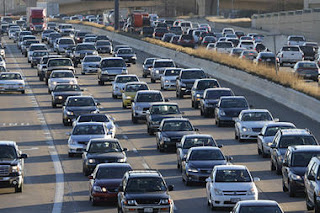Posted On: 04/03/2013 8:10:39 PM
Post# of 6596
The US could cut oil consumption for light-duty vehicles and greenhouse-gas emissions, if it adopts policies and encourages key technologies, a new National Research Council report says.
What is it that you're driving?
It would be a light, highly efficient vehicle. New cars in 2050 would have Corporate Average Fuel Economy (CAFE) ratings of about 74 miles per gallon, better than twice today's standards. It might be powered by a traditional internal combustion engine, a battery, or an engine burning biofuels, hydrogen, or natural gas. Your car would probably be cheap to run but cost several thousand dollars more to buy (and that's not counting inflation).
That's what the future might look like if the United States committed itself to reducing the oil use and greenhouse gas emissions from cars and light trucks, according to a new study by the National Research Council . The NRC, a private, Washington -based nonprofit, founded by congressional charter to provide expert advice on scientific matters, found that the US could meet the goal of an 80 percent cut in the oil consumption of light-duty vehicles (LDV) by 2050 if the federal government provided strong leadership.
But the prospects for cutting the greenhouse gas (GHG) emissions from LDVs by 80 percent look more challenging.
"Large reductions are potentially achievable in annual LDV GHG emissions by 2050, on the order of 60 to 70 percent relative to 2005," according to the study, which was released Monday. "An 80 percent reduction in LDV GHG emissions by 2050 may be technically achievable, but will be very difficult."
While the light-duty vehicle fleet consumes about half the oil that the US uses, it accounts for only about 17 percent of its greenhouse gas emissions. One of the straightforward ways to cut oil consumption is to convert or build a large number of cars and trucks to run on natural gas, the report said. That would be a logistical challenge, requiring a large network of natural-gas stations, but it's not technologically difficult.
Unfortunately, the US can't rely on natural gas to power cars if it also wants to reduce GHG emissions by 80 percent, the study finds. The engines emit too much GHG.
To cut oil consumption and GHG emissions, the NRC looked at four technological "pathways": making conventional vehicles much more efficient and encouraging the development of cars that run on biofuels, electricity, and hydrogen.
A big part of the effort would be to make conventional cars far lighter and efficient than today's models. That would mean federal policymakers would have to go well beyond the Corporate Fuel Economy (CAFE) standards set for 2025. Those standards call for new cars to achieve 54.5 miles per gallon. The study envisions a 74 m.p.g. CAFE rating. Hybrids might get 94 m.p.g. (CAFE ratings tend to be higher than real-world driving.)
Even those efficiencies wouldn't be enough to cut oil consumption by 80 percent, the study finds. "In addition, biofuels would have to be expanded greatly or the LDV fleet would have to be composed largely of CNGVs [compressed natural gas vehicles, such as the Honda Civic Natural Gas], BEVs [battery electric vehicles, such as the Nissan Leaf ]; and/or FCEVs [fuel-cell electric vehicles, such as the Mercedes F-Cell , due in 2014]."
Given the uncertainties in technological breakthroughs, all three of the alternative pathways should by explored, the study recommends, including the often maligned fuel-cell option. "The committee believes that hydrogen/fuel cells are at least as promising as battery electric vehicles in the long term and should be funded accordingly..."

